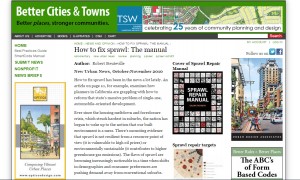How to fix sprawl has been in the news a lot lately. An article on page 10, for example, examines how planners in California are grappling with how to reform that state’s massive problem of single-use, automobile-oriented development.
Ever since the housing meltdown and foreclosure crisis, which struck hardest in suburbs, the nation has begun to wake up to the notion that our built environment is a mess. There’s mounting evidence that sprawl is not resilient from a resource point of view (it is vulnerable to high oil prices) or environmentally sustainable (it contributes to higher greenhouse gas emissions). The flaws of sprawl are becoming increasingly noticeable in a time when shifts in demographics and consumer preferences are pushing demand away from conventional suburbs.
